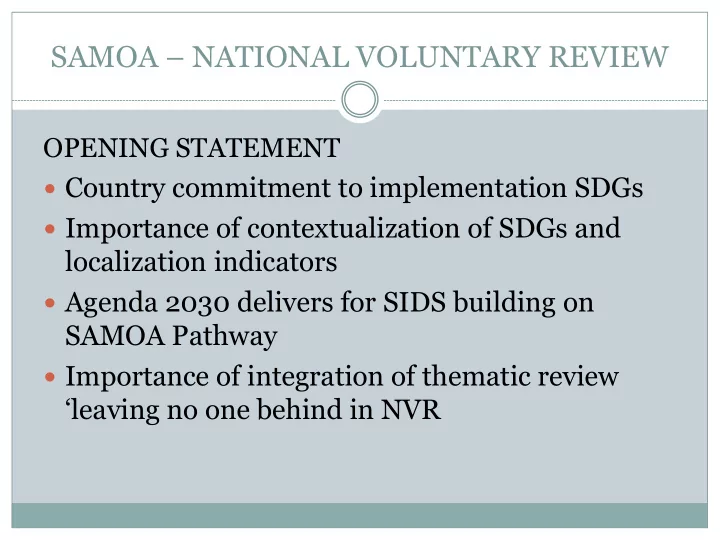

SAMOA – NATIONAL VOLUNTARY REVIEW OPENING STATEMENT Country commitment to implementation SDGs Importance of contextualization of SDGs and localization indicators Agenda 2030 delivers for SIDS building on SAMOA Pathway Importance of integration of thematic review ‘leaving no one behind in NVR
SNVR – Key Messages Alignment and mainstreaming of SDGs to National strategy for sustainable development Importance of contextualization and use of existing institutions, systems Centrality of statistics to monitoring and reporting There is integration of the 3 pillars of sustainable development Translating ambition to action requires investment in human capacity
SNVR - CONTEXT A small island developing state characterized by small size, extreme isolation, limited and narrow resource base, geographic dispersion and isolation from markets, diseconomies of scale, capacity limitations, susceptibility to climate change and natural disasters and global crises Politically stable Graduated out of LDC status in 2014 Ranked 105 out of 188 in the 2015 Human Development Index, placed in High Human development category Gender inequality index of 0.457 ranking it 97 out of 155 countries. Slow but positive economic growth Rising debt levels
SNVR – Methodology & Processes Preliminary assessment using Mid Term Review of SDS (national strategy sustainable development) Conduct of open inclusive and participatory consultations throughout country Mid Term review and annual sector review findings formed the building blocks for new SDS (2016-2020) Identification indicators for localistion Assessment global indicators against national and sectoral indicators
SNVR – Methodology & processes Mapping of global indicators using Tier classification showed that Samoa was able to provide 60% of the indicators from SBS and sectoral stakeholders. Remaining 40% constitute work in progress Mapping of goals, indicators and means of implementation is a result of collaboration among SBS, Ministry of Finance/Planning and all sectoral lead ministries Each goal has been assigned a lead ministry to coordinate implementation
SNVR – Overall Assessment SDS is generally SDGs SDS aligned to the G1-G6 & G10 unfinished Key Outcomes 1,2,5,7,6,8,9 business MDGs SDG goals and G7 Key Outcome 1, 12 targets. G8 Key Outcomes 1,2 & 5 G9 Key Outcome 9,10,11,12, 14 G10 Key Outcomes 1, 11 Important to G11 Key Outcomes 8, 13 Capture synergies G12 Key Outcome 1,13 G13 Key outcome 12, 13, & 14 early G14 Key Outcome 13 & 14 G15 Key Outcome 13 & 14 Important to use a G16 Key Outcome 1-14 nexus approach for G17 Partnership framework efficient and effective And development cooperation programs implementation
SNVR – Thematic review “leave no one behind’ Reflected in poverty reduction initiatives, identification vulnerable groups and addressing inequality Use of a human rights approach as reflected in commitments to UPR for human rights Legislative and policy reforms towards equality for all Realization civil and political rights, economic social and cultural rights Empowerment of women and girls vital to sustainable development Meaningful engagement civil society and youth groups
SNVR – Institutional mechanisms Use of sector wide approach including sector institutions and stakeholders for implementation Lead ministries of each of 14 sectors are responsible for a Goal for implementation National SDG Task Force drives monitoring and reporting processes Sector coordinators work with Task Force to review and assess indicators SBS has central role in monitoring but in collaboration with all other stakeholders All reports to be passed by Parliament
SNVR – MEANS of Implementation Implementation to be linked to budgetary and coordination mechanisms Implementation started with existing financial resources including TA facilities until development financing assessment is done MOI involves trade, capacity building, science technology and innovation, private sector engagement Durable partnerships crucial for implementation – review SIDS partnerships framework Use of Volunteerism as a means of implementation
SNVR - Challenges Include human and institutional capacity constraints, lack of ownership and political will, lack of awareness and engagement of stakeholders and the challenge of localizing the SDGs, lack of alignment with global and regional actions, insufficient resources and capacities of resource implementation, lack of baseline data and capacities to collect and analyse data and data disaggregation Making indicators relevant
SNVR – Good practices - Lessons learnt Mapping of goals, indicators, and means of implementation helps to identify gaps and strengthens statistical capability Close collaboration essential for harmonisation and disaggregation indicators and consistency concepts used Mapping at regional level important to confirm priorities of region. Samoa is member of regional SDG Taskforce Development of national and regional roadmaps – strengthens national/regional/global links Need strong leadership and political will for successful implementation Contextualised implementation important Capacity building essential to develop quality data
SNVR - Conclusion Total commitment of the Government of Samoa to the implementation of its development framework inclusive of the SDGs Samoa views and perceives the SDGs as a timely opportunity to address the development challenges ahead Early review for Samoa as a SIDS could provide encouragement for others to follow suit and learn from experience The preparation of the report for Samoa has generated a lot of public interest and awareness of the SDGs The integration and mainstreaming processes are carried out as a matter of priority at country level and that as much as possible, use existing systems and processes as well as institutions Understanding the different ways that 'leave no one behind' could be interpreted will make implementing the Sustainable Development Goals (SDGs) more effective in practice The consultation processes that have taken place as part of Samoa’s national preparations for its National Voluntary Review report has strengthened the framework for coordinated monitoring.
Recommend
More recommend